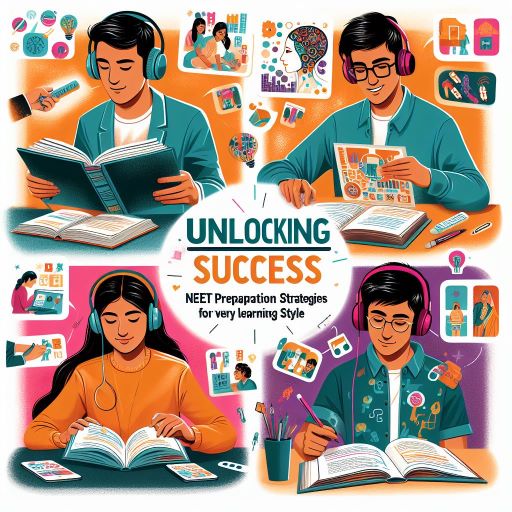Exploring NEET Preparation Strategies for Different Learning Styles: Visual, Auditory, and Kinesthetic
Table of Contents

Introduction:
Embarking on the journey to becoming a medical professional demands rigorous preparation, and the National Eligibility and Entrance Test (NEET) stands as a formidable challenge along that path. However, the approach to conquering this test is as diverse as the aspiring doctors themselves. Recognizing and catering to different learning styles can be the key to unlocking one’s full potential in NEET preparation.
In this blog post, we delve into the dynamic landscape of learning styles, exploring how visual, auditory, and kinesthetic learners can tailor their study techniques to excel in the NEET exam. From leveraging vibrant visuals to immersing in lively discussions and embracing hands-on experimentation, we’ll unveil strategies designed to empower each learner on their unique educational journey.
Also Read: NEET Preparation Strategies
Join us as we navigate the realm of NEET readiness, embracing the diversity of learning styles and paving the way for aspiring medical professionals to thrive. Whether you’re inclined towards the vivid imagery of visual learning, the melodic resonance of auditory learning, or the tactile exploration of kinesthetic learning, there’s a tailored strategy waiting to guide you towards success in the NEET exam.
NEET Preparation Strategies for Different Learning Styles
The National Eligibility and Entrance Test, or NEET, is a demanding test for prospective medical students that calls for extensive study. But not every student approaches studying in the same manner. While some people learn best with visual aids, others are better with aural or hands-on experiences. Comprehending and accommodating diverse learning styles can considerably augment the efficacy of NEET readiness. We’ll look at specific study techniques in this blog post to help visual, auditory, and kinesthetic learners succeed on the NEET exam.
1.Visual Learners:
Images, charts, and diagrams are among the visual stimuli that help visual learners better assimilate information. The following techniques can help these students get ready for the NEET:
- Use Charts and Diagrams: To organize and visualize complex information, use visual aids like flowcharts, concept maps, and diagrams. Topics that are broken down into visual representations are easier for visual learners to understand and retain.
- Watch Educational Videos: To enhance textbook learning, make use of online resources and instructional videos. Watching tutorials, animations, and demonstrations that visually explain complex concepts might be beneficial for those who are visual learners.
- Make Flashcards: To help with remembering, make flashcards with important terms, pictures, and drawings. Regularly going over flashcards can help to reinforce learning and enhance memory of key information.
2.Auditory Learners:
Auditory learners absorb information best through listening and verbal instruction, making them adept at understanding concepts through lectures, discussions, and verbal explanations. To support auditory learners in NEET preparation, consider implementing the following strategies:
- Attend Webinars and Lectures: Participate in live webinars, online seminars, and lectures where topics are spoken aloud. Real-time explanations and conversations of complex topics are beneficial for auditory learners.
- Listen to Audio Recordings: To help you understand and review concepts, you can use audio recordings of lectures and discussions. For the purpose of remembering knowledge and understanding complex ideas, auditory learners find that listening to recordings is beneficial.
- Take Part in Group Discussions: Participate in study sessions and group discussions where you can explain ideas, pose questions, and share thoughts with peers. Auditory learners use conversation and spoken exchange to enhance their understanding.
- Record and Listen to Notes: During study sessions, record your own voice explaining important concepts. Speaking aloud when receiving information can improve understanding and memory for auditory learners.
Also Read:
How to maintain consistency in Neet preparation Strategies in 2024
Inspirational Stories of NEET Toppers 2023
3.Kinesthetic Learners:
Kinesthetic learners are skilled at comprehending concepts through tactile encounters and real-world experiments. They learn best through hands-on activities and physical experiences. During NEET preparation, take into consideration putting the following tactics into practice to accommodate kinesthetic learners:
- Conduct Hands-On Experiments: Include practical exercises, dissections, and hands-on experiments in your study regimen. Kinesthetic learners gain from working with tangible items and getting hands-on experience with concepts.
- Employ Manipulatives and Models: To facilitate the exploration of intricate ideas through hands-on learning, make use of manipulatives, anatomy kits, and physical models. Hands-on inquiry and item manipulation help kinesthetic learners gain a deeper understanding.
- Take Regular Breaks for Movement: Throughout your study sessions, schedule brief pauses for movement and physical exercise. To keep focused and invigorated, kinesthetic learners benefit from taking breaks to stretch, walk, or do other physical activities.
- Apply application-based learning: By concentrating on finding solutions to real-world problems, integrating theoretical knowledge into practical situations, and participating in interactive exercises that support learning. When kinesthetic learners can immediately apply their knowledge and abilities in real-world situations, they flourish.
Conclusion:
Aspiring medical students face a significant obstacle in the form of the NEET test, which necessitates extensive preparation across multiple subject areas. However, students can maximize their study strategies and raise their chances of success by knowing and accommodating the various visual, aural, and kinesthetic learning styles. Kinesthetic learners do best with hands-on experimentation and tactile encounters; auditory learners do best with vocal explanations and discussions; and visual learners profit from visual aids.
Allow students to embrace their distinct learning styles and investigate tactics that align with their personal preferences and strengths as they set out on their NEET preparation journey. Students can pass the NEET exam and get closer to their goal of becoming doctors if they study hard, are flexible, and take a tailored approach to their education. NEET Preparation Strategies is necessary for achieving the goal.

